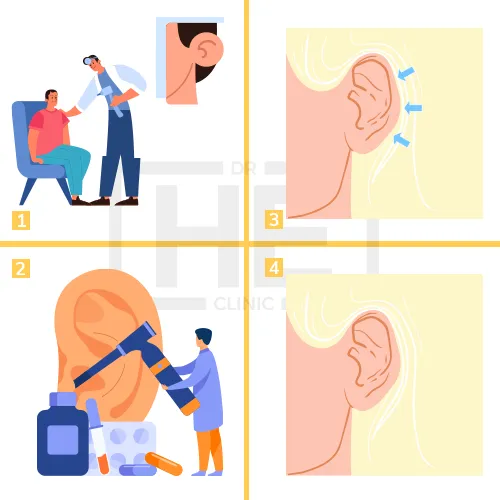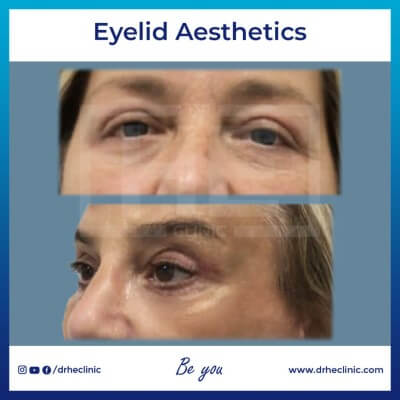What is Ear Aesthetics?

Ear Aesthetic Steps

1. Consultation
- Assessment: The first step is a consultation with a plastic surgeon who will assess the patient’s ears in relation to their facial features, discuss the desired outcome, and explain what can realistically be achieved with surgery.
- Medical History: The surgeon will review the patient’s medical history to ensure they are a good candidate for surgery. This includes discussing any previous ear surgeries, current medications, and any conditions that could affect healing.
- Procedure Explanation: The surgeon will explain the details of the procedure, including the technique that will be used, the risks, the recovery process, and the cost.
2. Pre-operative Preparations
- Instructions: Patients may receive instructions to stop taking certain medications or supplements that can increase bleeding, such as aspirin or ibuprofen, for a specified period before and after surgery.
- Planning for Recovery: Arrangements should be made for the recovery period, such as taking time off work or school and ensuring someone is available to drive the patient home after the procedure.
3. The Procedure
- Anesthesia: Ear aesthetic surgery is usually performed under local anesthesia with sedation or general anesthesia, depending on the extent of the surgery and the patient’s preference.
- Surgical Technique: The specific technique used depends on the nature of the correction. Common approaches include making incisions behind the ear to remove or reshape the cartilage and skin, and suturing the ear closer to the head for protruding ears.
- Closure: Incisions are typically closed with sutures, which may be dissolvable or may require removal after a certain period.
4. Recovery
- Immediate Aftercare: After the surgery, the ears are usually bandaged for support and protection. Patients might experience discomfort, swelling, and bruising, which can be managed with medication prescribed by the surgeon.
- Follow-up Visits: Patients will need to attend follow-up appointments to monitor their healing and remove any non-dissolvable stitches.
- Activity Restrictions: Patients are advised to avoid activities that could bend or harm the ears, and to follow specific guidelines about sleeping positions and physical activities to ensure proper healing.
5. Long-term Care and Outcome
- Final Results: The final results of ear aesthetics can take several weeks to become fully apparent, after the swelling and bruising have subsided.
- Continued Care: While the changes made during otoplasty are usually permanent, it’s important for patients to protect their ears from injury and follow any long-term care instructions provided by their surgeon.

Need Help? Contact Us!
7/24 Obesity Help Desk
Ear Aesthetics Turkey Cost 2025
The cost of ear aesthetics (otoplasty) in Turkey varies depending on the clinic, the complexity of the procedure, the surgeon’s experience, and whether additional services such as VIP transfers and hotel accommodations are included. Here’s a summary of the information gathered from various sources:
The average cost of otoplasty in Istanbul ranges from $2,000 to $3,050, with some clinics offering packages that might include additional services.
Specific procedures have their own price ranges, such as ear reconstruction starting from $1,634, prosthetic ear surgery from $3,150, and ear lift surgery from $1,634.
| Region | Average Ear Aesthetics Cost |
 Turkey Turkey | $2,000 – $3,050 or more |
 USA USA | $8,000 – $12,000 or more |
 Canada Canada | $8,000 – $12,000 or more |
 UK UK | £5,000 – £8,000 or more |
 Australia Australia | AUD 8,000 – AUD 15,000 or more |
 Germany Germany | €8,000 – €10,000 or more |
 France France | €7,000 – €10,000 or more |
Why does Ear Aesthetics Cost in Turkey Cheap?
- Exchange rate: Favorable exchange rates for foreign currencies relative to the Turkish lira can make procedures even cheaper for international patients.
- Standardized procedures: Many Turkish clinics employ standardized protocols and techniques for common procedures like ear aesthetics, achieving efficiency and cost savings.

Ear Aesthetics Before and After Photos
Submit your request for access to before and after photos to see actual patient results from our many cosmetic procedures and treatments at Dr. HE Clinic.
Ear Aesthetics Reviews


Posted on
Truspilot
Posted on
TruspilotIs it Safe To Have A Ear Aesthetics in Turkey?
Having Facial Aesthetics treatment in Turkey can be a safe and effective option for many individuals, provided that you carefully select healthcare providers and facilities. Turkey is known for its advanced healthcare services, especially in major cities like Istanbul, Ankara, and Izmir, where many hospitals and clinics cater to international patients.
Frequently Asked Questions About Ear Aesthetics
Does Health Insurance Pay for the Ear Aesthetics?
How Long Does Ear Aesthetics Take?
Ear aesthetics (otoplasty) surgery typically takes about 1 to 3 hours to complete, depending on the complexity of the procedure and the specific corrections being made.
Is Ear Aesthetics Painful?
Ear aesthetics (otoplasty) is generally not considered painful because it is performed under anesthesia (local or general, depending on the case). Patients may experience discomfort, swelling, and mild pain during the recovery period, but these symptoms are typically manageable with prescribed pain medication.
QUALITY CERTIFICATES
















Posted on
Truspilot